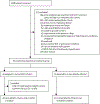Treatment with allogeneic mesenchymal stromal cells for moderate to severe acute respiratory distress syndrome (START study): a randomised phase 2a safety trial
- PMID: 30455077
- PMCID: PMC7597675
- DOI: 10.1016/S2213-2600(18)30418-1
Treatment with allogeneic mesenchymal stromal cells for moderate to severe acute respiratory distress syndrome (START study): a randomised phase 2a safety trial
Abstract
Background: Treatment with bone-marrow-derived mesenchymal stromal cells (MSCs) has shown benefits in preclinical models of acute respiratory distress syndrome (ARDS). Safety has not been established for administration of MSCs in critically ill patients with ARDS. We did a phase 2a trial to assess safety after administration of MSCs to patients with moderate to severe ARDS.
Methods: We did a prospective, double-blind, multicentre, randomised trial to assess treatment with one intravenous dose of MSCs compared with placebo. We recruited ventilated patients with moderate to severe ARDS (ratio of partial pressure of oxygen to fractional inspired oxygen <27 kPa and positive end-expiratory pressure [PEEP] ≥8 cm H2O) in five university medical centres in the USA. Patients were randomly assigned 2:1 to receive either 10 × 106/kg predicted bodyweight MSCs or placebo, according to a computer-generated schedule with a variable block design and stratified by site. We excluded patients younger than 18 years, those with trauma or moderate to severe liver disease, and those who had received cancer treatment in the previous 2 years. The primary endpoint was safety and all analyses were done by intention to treat. We also measured biomarkers in plasma. MSC viability was tested in a post-hoc analysis. This trial is registered with ClinicalTrials.gov, number NCT02097641.
Findings: From March 24, 2014, to Feb 9, 2017 we screened 1038 patients, of whom 60 were eligible for and received treatment. No patient experienced any of the predefined MSC-related haemodynamic or respiratory adverse events. One patient in the MSC group died within 24 h of MSC infusion, but death was judged to be probably unrelated. 28-day mortality did not differ between the groups (30% in the MSC group vs 15% in the placebo group, odds ratio 2·4, 95% CI 0·5-15·1). At baseline, the MSC group had numerically higher mean scores than the placebo group for Acute Physiology and Chronic Health Evaluation III (APACHE III; 104 [SD 31] vs 89 [33]), minute ventilation (11·1 [3·2] vs 9·6 [2·4] L/min), and PEEP (12·4 [3·7] vs 10·8 [2·6] cm H2O). After adjustment for APACHE III score, the hazard ratio for mortality at 28 days was 1·43 (95% CI 0·40-5·12, p=0·58). Viability of MSCs ranged from 36% to 85%.
Interpretation: One dose of intravenous MSCs was safe in patients with moderate to severe ARDS. Larger trials are needed to assess efficacy, and the viability of MSCs must be improved.
Funding: National Heart, Lung, and Blood Institute.
Copyright © 2019 Elsevier Ltd. All rights reserved.
Figures




Comment in
-
Cell-based therapies for acute respiratory distress syndrome.Lancet Respir Med. 2019 Feb;7(2):105-106. doi: 10.1016/S2213-2600(18)30477-6. Epub 2018 Nov 22. Lancet Respir Med. 2019. PMID: 30473410 No abstract available.
-
Precision medicine for cell therapy in acute respiratory distress syndrome.Lancet Respir Med. 2019 Apr;7(4):e13. doi: 10.1016/S2213-2600(19)30089-X. Lancet Respir Med. 2019. PMID: 30926050 No abstract available.
-
Precision medicine for cell therapy in acute respiratory distress syndrome - Authors' reply.Lancet Respir Med. 2019 Apr;7(4):e14. doi: 10.1016/S2213-2600(19)30083-9. Lancet Respir Med. 2019. PMID: 30926051 No abstract available.
-
Cell therapy for acute respiratory distress syndrome patients: the START study.J Thorac Dis. 2019 May;11(Suppl 9):S1329-S1332. doi: 10.21037/jtd.2019.04.22. J Thorac Dis. 2019. PMID: 31245124 Free PMC article. No abstract available.
References
-
- Thompson BT, Chambers RC, Liu KD. Acute respiratory distress syndrome. N Engl J Med 2017; 377: 562–72. - PubMed
-
- Bellani G, Laffey JG, Pham T, et al. Epidemiology, patterns of care, and mortality for patients with acute respiratory distress syndrome in intensive care units in 50 countries. JAMA 2016; 315: 788–800. - PubMed
-
- Matthay MA, Pati S, Lee JW. Concise review: mesenchymal stem (stromal) cells: biology and preclinical evidence for therapeutic potential for organ dysfunction following trauma or sepsis. Stem Cells 2017; 35: 316–24. - PubMed
-
- Walter J, Ware LB, Matthay MA. Mesenchymal stem cells: mechanisms of potential therapeutic benefit in ARDS and sepsis. Lancet Respir Med 2014; 2: 1016–26. - PubMed
Publication types
MeSH terms
Associated data
Grants and funding
LinkOut - more resources
Full Text Sources
Other Literature Sources
Medical

